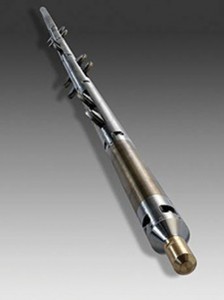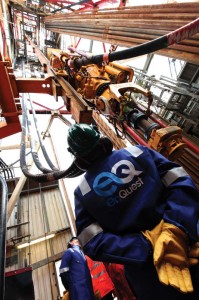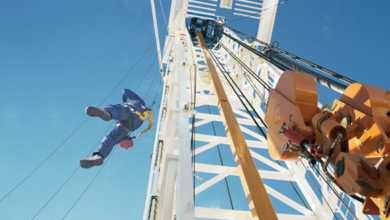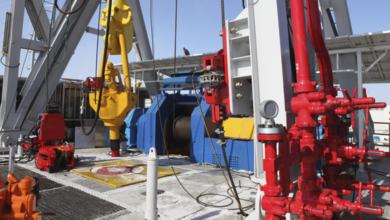Drilling & Completion Tech Digest
Sinopec group sets depth record on Sichuan Basin HPHT well
Sinopec Research Institute of Petroleum Engineering (SRIPE) and APS Technology have achieved a depth record on a high-pressure, high-temperature (HPHT) well in China.
SRIPE completed drilling two sections of Well YuanBa272H in China’s Sichuan Basin in April, with true vertical depth of 6,670 meters (21,883 ft), total depth of 7,580 meters (24,869 ft) and a horizontal section of 600 meters (1,968 ft). The APS SureShot MWD tool that was used encountered temperatures as high as 147°C static and 138°C circulating and pressures up to 140 MPa (20,305 psi) during the job.
“Despite the challenges of high flow velocities, high hydrogen sulfide, high vibration and high shocks, the APS SureShot MWD and surface system delivered the performance this job required, with very few problems,” said Liu Kuanxiao, expert senior engineer at SRIPE.
RSS for unconventionals drills 2 million-plus ft
Baker Hughes’ AutoTrak Curve rotary steerable system has drilled more than two million ft in unconventional shale plays in the 18 months since the first test wells and six months since the system’s commercial launch.
Operators have cited the rotary steerable system for saving time, improving well placement and incremental production, the company said. The system can drill vertical, curve (15°/100 ft) and horizontal sections in one run to maximize available pay zones and reduce the number of trips. The system drills what used to take two to three trips in one run.
The closed-loop drilling system takes commands from the surface to place the wellbore in the desired location. Making real-time adjustments to the steering target while drilling, the wellbore can be placed in the right spot. Watch a DC exclusive video about the AutoTrak Curve rotary steerable system.

Statoil to build Norway’s biggest IOR research center, hires Welltec, Aker for wirelines services on NCS
Statoil has awarded wireline service contracts to Welltec and Aker Well Services to deliver solutions for equipment deployment and maintenance in horizontal wells on more than 40 installations on the Norwegian continental shelf (NCS).
“Wireline tractor services represent a vital and cost-effective tool for maintenance in our horizontal wells. Maintenance and repair of wells is one of the most important measures we have to increase recovery,” Øystein Arvid Håland, head of drilling and well in Statoil, said.
The contract period is four years and will run from 1 February 2013 until 31 January 2017.
As part of Statoil’s plans to increase the recovery rate on the NCS from 50% to 60%, the company has commenced building Norway’s biggest research center for improved oil recovery in Trondheim. The center, which will cost around NOK 240 million, is due for completion around the end of 2013.
The center, which is being built adjacent to Statoil’s research center at Rotvoll in Trondheim, will consist of four floors that prioritize areas of technology, such as drilling and well, reservoir mapping and advanced injection techniques. The heart of the roughly 2,700-sq-meter large center will be an industrial CT scanner that is 100 times more powerful than a medical CT scanner.
Apache to drill top holes with RMR in Australia
Apache Energy has signed up to use AGR’s Riserless Mud Recovery (RMR) system during batch drilling of six top holes on its Coniston Development, offshore Western Australia, pending receipt of necessary government and other approvals for the project, which are anticipated later this year.
RMR was decided to be used on these wells because of its ability to drill deviated top holes through an unconsolidated sand formation with full mud return and with less probability of hole collapse and stuck pipe situations.
“Our previous experiences with several operators in the Browse Basin and North West Shelf have shown that unconsolidated sand formations become much more benign when drilled with RMR using a proper mud system,” Bernt Eikemo, vice president of EDS-ORS Asia Pacific, a division of AGR, said.
DNV launches new offshore power generation system
DNV has launched the Offshore Power system for a new era (OPera) to eliminate the need for topside processing power generation at each unit, increasing available deck space.
With its centralized location, OPera allows improvements in operational logistics by consolidating the location of power generation personnel, maintenance and spare parts. The power generation arrangement may reduce CO2 emissions by approximately 40% and increase power generation efficiency by more than 15%.

EnQuest reaches five LTI-free years on North Sea’s Thistle platform
EnQuest has reached a North Sea safety milestone by recording five years free of lost-time incidents (LTIs) on drilling operations in the Thistle field.
Supported by a KCA DEUTAG drill crew, an Aker Solutions well services crew and other offshore contractors, EnQuest’s drilling team has taken Thistle from a rig upgrade to rig startup, followed by two-and-a-half years of drilling operations involving workovers, sidetracks and the installation of three electrical submersible pumps.
The LTI achievement covers a period of major operational activity, which saw EnQuest bring Thistle drilling back online to drill its first new wells in 20 years.
“Over one million man hours have been worked during the five years without an LTI, which is an outstanding achievement under any circumstances but particularly given the challenges our team has faced in bringing Thistle drilling back online,” David Heslop, general manager at EnQuest, said. “EnQuest‘s principal aim is to deliver safe results, and this is a great example of how collaboration underpinned by a robust safety culture can achieve exceptional performance safely.”
EnQuest’s Thistle platform is undergoing a program of modifications and upgrades as part of the company’s late life extension strategy to develop sustainable growth through the exploitation of mature fields.
BP boosts recovery with low-salinity water injection
BP will deploy for the first time reduced-salinity water injection (LoSal EOR) to help increase the amount of oil that can be recovered from the UK’s largest hydrocarbon resource. The Clair Ridge development, west of Shetland, UK, is the first sanctioned large-scale offshore enhanced oil recovery scheme using LoSal EOR.
The $7.2 billion development includes around $120 million for the desalination facilities to create low-salinity water for waterflooding from sea water. BP estimates this will enable the production of approximately 42 million barrels of additional oil, making a significant contribution to the estimated 640 million barrels of recoverable oil from the development.
The Mad Dog Phase 2 project in the US Gulf of Mexico is the second offshore project that plans to include a low-salinity waterflood to support increased oil recovery from the field. The facility will have a low-salinity waterflood injection capacity of more than 250,000 barrels of water per day.
The technology has been successfully tested in a field trial in the Endicott field, Alaska, between 2008 and 2009, where low-salinity water was injected in one well and the incremental oil production observed in another.
InterMoor, China Offshore Oil Engineering complete permanent mooring in South China Sea’s Lufeng field
InterMoor has completed its first permanent mooring work in the Lufeng oilfield, South China Sea. The project was also the company’s first for Chinese installation contractor China Offshore Oil Engineering.
The Nanhai Sheng Kai floating, storage and offloading unit (FSOU) has been in service since 1992, surpassing its 12-year estimated design life. To facilitate continuing production from Lufeng field and the expansion of the LF 13-2 oilfield, the fields’ operator, China National Offshore Oil Corp (CNOOC), is extending the service life of the FSOU by 15 years by upgrading and relocating its mooring system to LF 13-2 oilfield.
During the five-month contract, InterMoor’s work included project management, engineering, procurement and installation for a new buoy turret mooring system for the upgraded Nanhai Sheng Kai FSOU in LF 13-2 field. Additionally, InterMoor spearheaded the installation of a new 8-in. flexible flowline and riser between the buoy turret mooring system and the LF 13-2 wellhead platform.
InterMoor has also recently placed the largest chain order by length of any provider in recent years with one of the world’s largest chain manufacturers.
More than 32 km of 84- and 76-mm chain is on order for delivery at the end of the year. The chain will be used primarily to support the company’s preset mooring programs or add on to the mooring components of drilling rigs.
Chesapeake treats non-aqueous cuttings onsite in Eagle Ford
Chesapeake Energy is treating non-aqueous drilling fluid (NADF) cuttings with TWMA in the Eagle Ford. TWMA’s TCC RotoTruck removes non-aqueous base fluid (NABF) from the cuttings to an acceptable 0.0123% average total petroleum hydrocarbon, which is below local discharge requirements.
TWMA has processed 3,500 tons of NADF cuttings, recovering more than 3,000 barrels of NABF for reuse. The recovered fluid contained little or no solids, representing 100% efficiency from material processed. Remaining solids exit the system as a dry powder and can be disposed of onsite along with the recovered water.



